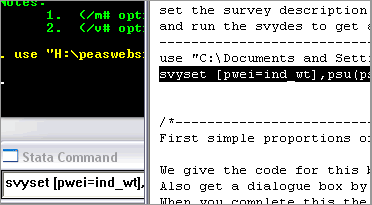

Southern Asia and sub-Saharan Africa are home to a staggering 48 and 24% of the global LBW burden, respectively. According to the lancet report in 2019, the 2015 LBW prevalence varied 14 to 17% globally, with more than 90% occurring in low-and-middle income countries. Of all births globally, 15 to 20% are estimated to have LBW, which would translate into over 20 million births annually. Īccording to the World Health organization (WHO), LBW is defined as weight at birth of less than 2500 g.
#SVYSET STATA DRIVER#
Not only does prematurity lead to mortality, but it has also been shown to be a driver of many health problems such as developmental delay and Low Birth Weight (LBW). Globally, prematurity related complications remain the leading cause of under-five mortality. To redress the observed education disparity in LBW, targeted interventions need to be implemented with greater emphasis placed on illiterate women.Īn estimated 15 million babies are born preterm (born before 37 completed weeks of gestation) annually worldwide.

We have identified education gradient in LBW, with the highest burden of LBW occurring among the non-educated women. However, no gradient in LBW was detected for household wealth. The findings showed that socioeconomic gradient was evident between maternal education and LBW as education increases from no education to secondary education, the probability of occurrence of LBW consistently declined. Resultsġ3.2% (95% confidence interval = 10.73, 15.65) of births were complicated by LBW. Maternal education and household wealth were used as measures of the socioeconomic position in the study. We performed sensitivity analysis to evaluate variation of LBW according to different categories of socioeconomic position. Multivariable logistic regression model and marginal standardization were used to estimate socioeconomic gradient in the probability of LBW. The data are available to the public domain and were accessed from the MEASURE DHS following registration. The study pursued complex sampling strategy to draw samples representative at national as well as at urban and rural levels. Women aged 15 to 49 years were the main focus of the survey, with data also gathered from men aged 15 to 59 years and under five children.
#SVYSET STATA SERIES#
The 2016 EDHS is the fourth wave in the series of nationally representative household surveys carried out in the country to deliver up-to-date health and demographic indicators for the Ethiopian population. Methodĭata for the study were drawn from the Ethiopia Demographic and Health Survey conducted in 2016. The study aimed to examine the prevalence of and socioeconomic gradient in LBW in Ethiopia. Such evidence, however, is scanty in Ethiopia. Evidence suggests appearance of socioeconomic gradient in the probability of low birth weight (LBW).


 0 kommentar(er)
0 kommentar(er)
